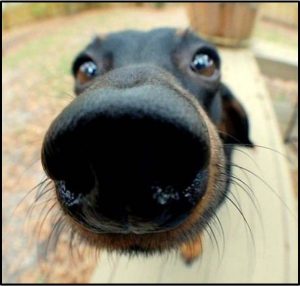
We’ve all been on the receiving end of one of these. But how much do we really appreciate the keen sense of smell that dogs have?
We’ve recently published a couple of articles on how the fact that dogs’ sense of smell is so acute that they can be trained to sniff out, among other things, certain kinds of cancers. But what do we really know about our best furry friend’s nose, other than it can sometimes get a dog into mischief?
Here’s an interesting article from InSutu about how a dog’s nose works, and why it can be so accurate. We hope you find it interesting.
A dog’s nose is an exquisite piece of machinery, capable of smelling in parts per trillion. When making the analogy to human vision, what you and I can see at 1/3 of a mile, a dog could see at more than 3,000 miles away, and see just as clearly.
Layered Scents
It is almost impossible to understand the magnitude of a dog’s sense of smell, especially when compared to ours. You and I smell chocolate cake, for example, but a dog smells the parts of the cake: sugar, flour, eggs, butter, vanilla, salt, etc. Dogs have the ability to layer scent, which is why they can detect your footprints on the floor, even though many other people have walked over your tracks. A dog can smell fingerprints on a wall that are weeks old, which are undetectable to humans. A dog’s whole world is based in scent. Everything has a smell. When you come home from a long day out, odors from everywhere you went that day are picked up by your dog, upon arriving home.
100,000 Times More Accurate
A dog’s sense of smell is up to 100,000 times more acute than ours. Dogs “smell in stereo”, with each nostril splitting into two parts, one for smelling, and one for respiration. Scientists say that if you can detect a teaspoon of sugar in your coffee, a dog could detect a teaspoon of sugar in a million gallons of water, or two Olympic-sized pools worth of water. Another scientist made the analogy of a dog being able to catch a whiff of one rotten apple in two million barrels.
Which Way Did He Go?
Studies show that dogs can tell which direction a person has walked down a trail. The first step in the direction that the person walked has a little less odor than subsequent steps, because its odor molecules have begun to diffuse into the air.
Military Dogs
Dogs have been trained and deployed by our military and government to protect our aircrafts and airports in search of bombs and narcotics, and many don’t know that a dog accompanied soldiers into Osama Bin Laden’s compound on that final day, pointing soldiers up the stairs and ultimately leading to Bin Laden. In our country, thousands of dogs are deployed every day, including dogs for agriculture detection, bomb and narcotics detection, criminal apprehension, money detection, contraband, missing persons, police, seizure detection, and even bedbugs. It is the most logical step to consider that a dog can also smell disease.
You Smell Happy!
A dog is able to smell the hormones you emit when you’re happy, nervous, or scared. A dog does not read your behavior and body language with his eyes, he literally “smells” if you’re happy, or sad. He can pick up on the tiny amounts of perspiration when you are having a stressful thought. Dogs can smell tiny parts of adrenaline that are emitted from your body, making you feel that your dog is psychic, however, these abilities are all scientifically based in a dog’s ability to smell our emotions.
300 Million Receptors
A dog has 300 million scent receptors in his nose, and a human has only 5 million. Not only does a dog have 295 million more scent receptors than us, but relatively speaking, the part of the dog’s brain that is dedicated to analyzing these odors is 40 times greater than ours.








